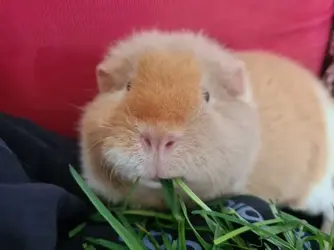I have lost two pigs to bladder stones and vowed that this wouldn’t happen again. I keep them on a very low Ca diet and also feed them Oxbow Urinary Health biscuits - it is beyond adorable that Strawberry comes up to me for her biscuit every morning

Seriously, I adopted a couple of pigs last year and the sludge in their wee was concerning to me. And then one of them did bloody wee. She was fine, she wasn’t in pain (obviously I would have taken her to the vet if she was). I decided to flush her out with cucumber, celery and watermelon - and it worked! I have been loathe to take guineas to the vet with bloody wee because in my previous experience they have said that they have to take them in for an ultrasound (£££) and blanket prophylactic antibiotics.
Last week my other adopted piggie started doing little patches of bloody wee. Although she is fine in herself I thought it was best to get her checked out. I live in a small country town and was aware that the good piggie vet had left, so I was really worried. I didn’t need to be though…
The new vet (I hope he isn’t just a locum!) was brilliant. Before he even examined Pebble he showed me the correct IV torch that you can buy on Amazon to check for porphyrine in urine and diagnostic sticks to check for blood. He was so cool - he said that basically you are just paying for vet time when diagnostic urine sticks will cost you pennies.
He then went on (still before examining her) to say that a big healthy wee can be accompanied shortly after by a small bloody wee. This is apparently because the bladder has a first flush and due to gravity, the bloody wee comes out afterwards. He then went on to examine her and he was so kind to her - she is nervous even by guinea pig standards! At first instinct he couldn’t detect bladder stones and he was honest about that. He gave her the usual health checks: heart, teeth, ears.
I was a bit reticent but I told him that Strawberry had done bloody wee previously and I could relate it to a high Ca thing that I had given them. I gave her loads of cucumber, celery, watermelon etc. to flush it out - which worked! This vet completely endorsed this. He is totally against blanket prescribing of Baytril (and antibiotic resistance)- we had a joke about how disgusting Baytril tastes - this vet is a keeper.
According to the vet’s advice, Pebble has to eat cucumber, celery and watermelon - poor Pebble


